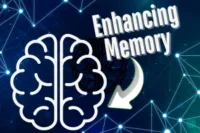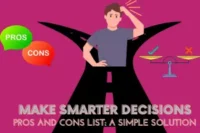Building Sustainable Digital Habits: Your Post-Detox Action Plan
Published: 25/07/2025
You aced your digital detox – congratulations! You’ve successfully unplugged from the digital world, hit the reset button, and found some much-needed clarity. But now, here comes the real challenge: how do you prevent those old habits from creeping back in? How do you stay grounded in the digital world while avoiding burnout, distraction, and the pull of constant notifications? The work isn’t over yet.
The digital world is intentionally designed for addiction. It’s a subtle, sneaky system that pulls you in with endless scrolling, ever-popular social media, and the relentless pinging of notifications. You might think you’ve escaped, but the truth is, it’s all too easy to fall back into these habits, especially when the digital clutter starts to reappear. While many detox guides promise relief, they often miss a crucial piece – a sustainable “re-entry” strategy.
What happens when your detox ends? Without a plan, it’s almost inevitable that the old patterns will creep right back in. And there’s more—our digital habits have a hidden environmental cost. From excessive energy consumption by our devices to the growing e-waste problem, the impact is real, and it’s time we start considering it as part of the solution.
But here’s the good news: This isn’t just another detox guide. This comprehensive action plan will provide you with concrete, step-by-step strategies to cultivate truly sustainable digital habits that benefit both your well-being and the planet. We’ll dive into how to protect your mind from digital overload, reduce your digital footprint, and implement long-lasting solutions that ensure your post-detox gains last a lifetime. By the end of this guide, you’ll have the tools to be more mindful, intentional, and environmentally conscious in your digital life, setting yourself up for lasting balance.
Reclaiming Your Digital Space – The Post-Detox Foundation
Now that you’ve successfully detoxed from the digital world, it’s time to set a solid foundation that will keep your post-detox gains intact. Reclaiming your digital space means intentionally restructuring your digital environment so that it aligns with your wellness goals and supports your long-term balance. It’s not about cutting out technology altogether—it’s about mastering how, when, and where you engage with it. Here are some actionable steps to help you build that foundation.
The “Digital Audit” Deep Dive: What Stays, What Goes, and Why?
The first step in reclaiming your digital space is to conduct a thorough “digital audit.” This is not a quick, surface-level clean-up; it’s a deep dive into your entire digital ecosystem. It’s time to go beyond the initial detox and take a granular approach to decluttering. Here’s how you can start:
- Unsubscribe Ruthlessly from Newsletters: We’ve all signed up for newsletters at some point. While some may still be valuable, many others serve only to clutter your inbox and waste your time. Use batch processing to unsubscribe from any irrelevant or non-essential subscriptions. Tools like Unroll.Me can help you identify and unsubscribe from multiple lists at once, saving you time and mental energy.
- Delete Unused Apps: Do a deep dive into your apps and identify which ones you rarely use. Uninstall those that aren’t serving you. Pay attention to the apps that consume the most data or trigger unnecessary notifications—these are often the ones that fuel digital distraction. You can analyze your screen time reports (available on most smartphones) to pinpoint which apps are taking up your time and energy.
- Cloud Storage Clean-Up: Just like physical clutter, your digital space can get bogged down with unnecessary files. Take the time to clean up your cloud storage. Delete duplicates, organize files into clear folders, and evaluate what’s actually worth keeping. Keep in mind that stored data has an environmental cost—it takes up energy in data centers. By reducing unnecessary files, you’re not only decluttering your life, but you’re also making a small but meaningful contribution to reducing your digital footprint.
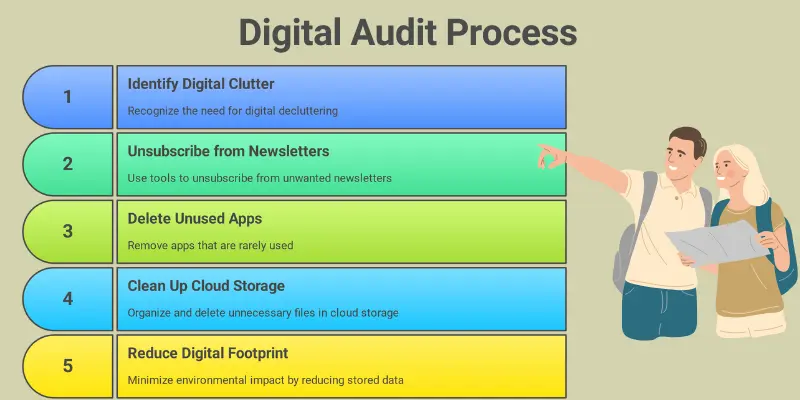
Sarah’s Story: Reclaiming Time & Peace Through Digital Decluttering
After her digital detox, she realized that the constant backup of photos, documents, and apps was contributing to unnecessary mental clutter. By doing a cloud clean-up and unsubscribing from newsletters, she was able to reclaim hours of her week and found a new sense of peace, free from constant notifications and a cluttered phone.
Setting Intentional Boundaries: Time, Place, and Purpose for Tech
One of the biggest challenges after a digital detox is how to prevent old habits from creeping back in. The key here is setting intentional boundaries that prioritize your well-being while allowing technology to serve your needs. Rather than just reducing screen time, aim for better screen time. Here’s how:
- Implement “Tech-Free Zones”: Create physical and mental boundaries by designating areas in your home where tech is off-limits. The bedroom and dinner table are prime examples. These zones can help you preserve important, non-digital activities like restful sleep and meaningful conversations. Consider leaving your phone in another room or on silent during meals to avoid distractions.
- Define “Digital Work Hours” vs. “Digital Leisure Hours”: Set clear boundaries for when you use technology for work and when you use it for leisure. This prevents work from seeping into your personal time. For example, define your “work hours” for emails and professional tasks, then stick to “leisure hours” for entertainment and social media. This structure helps maintain a sense of balance.
- The “Single-Purpose” Rule: One of the easiest ways to cut down on distraction is by committing to a single-purpose approach. Use your phone for one thing at a time—whether it’s making a call or checking your calendar, stay focused. The more you commit to single-tasking, the less likely you are to fall back into the trap of endless scrolling.
Crafting a Distraction-Free Digital Environment (Advanced Setup)
Now that you’ve tackled boundaries, let’s dive deeper into the digital tools you can use to make your environment more conducive to focus and mindfulness. A well-set-up tech environment can help you stay in control, rather than letting tech control you.
- Mastering Notification Settings: Notifications are one of the biggest culprits in digital distractions. Go through your devices and apps to master your notification settings. Decide which ones are essential (like text messages from close family) and which ones can be silenced (like social media alerts). Use Do Not Disturb settings strategically—set it to activate during meals, meetings, or before bed.
- Grayscale Mode & “Do Not Disturb” Automation: Grayscale mode can reduce the temptation to scroll endlessly, especially on social media apps. You can set your phone to grayscale during specific times, such as when you’re working or winding down. Combine this with Do Not Disturb automation to ensure you don’t get pulled into non-essential digital activities during your focused hours.
- Organizing Apps for Efficiency: Keep your home screen minimalistic by organizing apps into folders. This reduces visual clutter and helps you avoid mindlessly opening apps. Consider grouping apps by purpose (e.g., work apps, social apps, and entertainment) so that when you do access them, it’s with intention and focus.
By intentionally crafting a distraction-free digital environment, you create a space where you are in control, allowing technology to serve your needs while minimizing unnecessary distractions.
This section focused on setting the foundation for your post-detox journey. The key to sustainable digital habits lies in reclaiming your space—digitally and physically—by setting intentional boundaries, cleaning up unnecessary data, and creating a focused, efficient environment. With these strategies, you’re laying the groundwork for a balanced, intentional relationship with technology that lasts well beyond your initial detox.
Mindful Engagement – Shifting Your Daily Digital Habits
As you move beyond the passive setup of reclaiming your digital space, the next step is actively engaging with technology in a mindful, intentional way. It’s about shifting from reactive use (where technology pulls you in) to conscious consumption (where you take control of how and when you engage). This section will guide you through key habits that transform your digital life from mindless scrolling to purposeful interaction.
The Art of Conscious Consumption: From Reactive to Intentional Use
In a world dominated by constant notifications and information overload, it’s easy to become a passive consumer of digital content. However, mastering the art of conscious consumption is critical for maintaining balance. By being mindful of how you engage with technology, you can reclaim your time and energy. Here’s how to get started:
- Social Media: Social media can quickly devolve into a rabbit hole of endless scrolling, but there’s a strategy that can help: the “Check-in, Engage, Exit” approach. This method involves:
- Check-in: Open your social media app with a specific goal in mind (e.g., to check on a friend’s post or reply to a message).
- Engage: Spend time engaging with the content or people that matter to you.
- Exit: Close the app once you’ve achieved your goal, avoiding the temptation to scroll mindlessly.
- News & Information: “Doomscrolling” is an all-too-common habit that leads to increased anxiety and information overload. To prevent this, curate your news sources and set dedicated times for news consumption (e.g., reading news only in the morning or during lunch). This creates boundaries around when and how you engage with potentially stressful information. Consider using news aggregation tools like Feedly to create a curated feed of topics you care about, and avoid getting lost in irrelevant content.
- Streaming & Entertainment: Modern streaming platforms are designed to keep you watching with features like autoplay. To combat this, pre-select your content before sitting down to watch. Decide what you’ll watch in advance, and avoid the temptation to scroll endlessly through recommendations. If possible, turn off autoplay and make it a habit to be conscious about what you’re consuming. Recognizing mindless consumption cues (e.g., continuing to watch a show just because it’s on) helps you make intentional decisions about how you spend your leisure time.
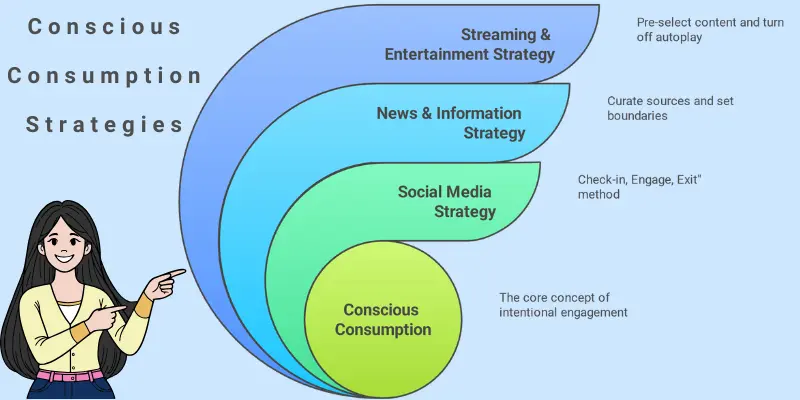
Example:
Meet John, a busy professional who struggled with wasting hours on social media each week. By adopting the “Check-in, Engage, Exit” strategy, he reduced his social media time by half. This small shift helped him reclaim hours that he now spends on hobbies and connecting more meaningfully with his friends and family.
Greening Your Inbox & Cloud: Efficient Digital Stewardship
It’s not just about your time; it’s also about how your digital habits impact the environment. By making your digital spaces more efficient, you can reduce your digital footprint and contribute to sustainability. Here’s how to approach digital stewardship with an eco-conscious mindset:
- Email Zero vs. Email Minimalism: Achieving “Inbox Zero” might seem impossible, but a minimalist approach to email management is more realistic and just as effective. Start by unsubscribing from unnecessary newsletters, deleting irrelevant emails, and archiving important ones. Email servers require energy to store and process your messages, so minimizing your inbox helps reduce the overall demand on data centers. A clean inbox not only gives you peace of mind but also reduces your environmental impact.
- Cloud Storage Optimization: Cloud storage is often a hidden contributor to unnecessary energy use. By organizing and deleting redundant files, you can minimize the amount of data stored across platforms. Go through your cloud storage (Google Drive, Dropbox, iCloud) and delete duplicates, outdated documents, and files you no longer need. You may be surprised how much space you’ve accumulated over the years that can be freed up with a little decluttering.
- Understanding Data Centers’ Energy Use: Data centers, where our digital content is stored, consume enormous amounts of energy. The more data we store (emails, photos, videos, apps), the higher the demand on these centers. By reducing unnecessary digital clutter, you’re helping reduce energy consumption, making your digital life more eco-friendly.
Ethical Tech Use: Privacy, Data, and Digital Citizenship
We live in an era where our digital footprint extends far beyond what we consume—it’s also about the data we generate and the impact it has on others. Mindful, ethical tech use involves being conscious of how our online behaviors affect not only our lives but also the environment and the people around us. Here are key steps to ensure that you’re practicing ethical digital citizenship:
- Regular Privacy Settings Reviews: Your privacy settings should be regularly updated, as social media platforms and apps often change their policies. Take time to review and adjust settings on social media, apps, and browsers to limit the amount of personal information you’re sharing. This could mean disabling location tracking, adjusting who can see your posts, or blocking unnecessary data collection.
- Understanding Data Collection and Its Impact: The data we produce through browsing, social media interactions, and app usage is invaluable to companies. Be aware of how your data is being used, particularly for targeted ads. Some apps might consume more energy while tracking your behavior, so it’s important to assess whether the app is worth the environmental impact.
- Practicing Respectful Online Communication: The digital world can often feel impersonal, but that doesn’t mean we should engage disrespectfully. Avoid digital negativity by practicing empathy and kindness in your interactions. Treat others with respect, just as you would in face-to-face interactions. In this way, you contribute to a healthier, more supportive online space.
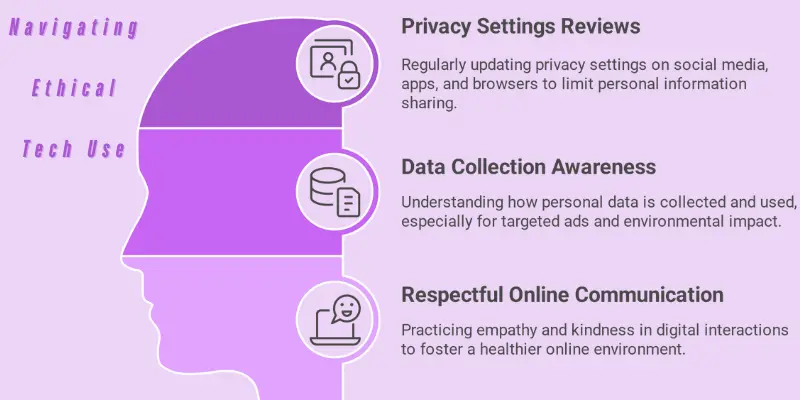
Shifting your daily digital habits from reactive to intentional is one of the most important steps you can take to ensure that your digital balance is sustainable. By practicing mindful consumption, taking steps to reduce your digital footprint, and engaging with technology ethically, you’re not only enhancing your well-being but also helping to create a more sustainable and respectful digital environment for everyone.
Eco-Conscious Tech Choices – Reducing Your Digital Footprint
In today’s world, technology isn’t just a personal convenience; it comes with a significant environmental cost. From e-waste to the energy consumption of data centers, the tech we use can harm the planet. In this section, we’ll explore actionable steps to reduce your digital footprint while making eco-conscious choices. These changes not only help protect the environment but also extend the lifespan of your devices, saving you money in the long run.
Extending Device Lifespan: The Ultimate Eco-Friendly Action
One of the simplest, most impactful ways to reduce your digital footprint is by extending the lifespan of your devices. Rather than replacing your tech every time a new model is released, consider the long-term environmental and financial benefits of prolonging the life of your devices. Here’s how to do it:
- Care and Maintenance Tips:
- Battery Health: A device’s battery is often its most vulnerable component. Avoid overcharging your phone or laptop. When charging, unplug once it reaches 100% to prevent overuse. For older devices, consider replacing the battery instead of buying a whole new device.
- Software Updates: Keeping your device updated isn’t just about security—it also ensures that your device runs efficiently. Outdated software can drain battery life and reduce performance, leading to the temptation to upgrade. Regularly check for updates and install them.
- Cleaning: A simple physical cleaning (removing dust, dirt, and debris) can improve your device’s performance and longevity. Invest in microfiber cloths, screen wipes, and compressed air to keep your devices in top shape.
- Repair vs. Replace:
- When to Fix: If your device is still functional but facing issues (e.g., cracked screen, faulty charging port), it’s often worth repairing rather than replacing it. Many local repair shops offer affordable solutions for common problems.
- Where to Find Repair Resources: Websites like iFixit provide step-by-step guides for repairing various tech devices. Some manufacturers, like Apple and Samsung, offer official repair programs to extend the lifespan of their products.
- Second-hand Tech: Instead of buying brand-new gadgets, consider buying second-hand or refurbished devices. Not only is this cost-effective, but it also reduces e-waste. Websites like eBay and Swappa are great places to find pre-owned tech. Similarly, you can sell or donate your old devices, keeping them out of landfills.
Example:
In a small town, a community repair initiative called TechCare was launched, where volunteers taught people how to repair their old devices. One member, Lisa, fixed an aging laptop and extended its life by another 2 years. This simple action saved her money, reduced waste, and gave her a deeper appreciation for her tech’s value.
Opting for Green Tech & Services: Making Informed Choices
When it’s time to purchase new tech, choosing eco-friendly products can make a big difference in your overall digital footprint. Here’s how to make informed, sustainable choices:
- Understanding Eco-Certifications for Electronics:
- Energy Star: This certification is awarded to products that meet energy efficiency standards. Look for the Energy Star label when buying electronics like laptops, monitors, and appliances. Energy-efficient devices use less electricity, saving you money on your energy bill while reducing carbon emissions.
- EPEAT: The Electronic Product Environmental Assessment Tool (EPEAT) evaluates products based on their environmental impact, such as recyclability and hazardous materials used. EPEAT-registered products are typically more eco-friendly and sustainable.
- Choosing Energy-Efficient Devices:
- Laptops vs. Desktops: If you’re in the market for a new device, consider opting for a laptop over a desktop, as laptops typically consume less power. If a desktop is necessary, look for energy-efficient models with a low power consumption rating.
- Monitor Types: When choosing a monitor, consider energy-efficient LED models. These use less power and last longer than traditional LCD screens.
- Exploring Green Web Hosting Providers and Cloud Services:
- Green Web Hosting: If you run a website or blog, opt for green web hosting providers that use renewable energy sources to power their servers. Companies like GreenGeeks and DreamHost are leading the way in providing sustainable hosting options.
- Cloud Storage Services: Some cloud services are more energy-efficient than others. Look for companies that prioritize green data centers, like Google Cloud and Microsoft Azure, which use renewable energy to power their operations.
The Hidden Energy Footprint of AI & Modern Computing
As technology continues to evolve, one of the most pressing environmental concerns is the energy demand of artificial intelligence (AI) and modern computing. These technologies, while groundbreaking, require vast amounts of energy to run. Here’s a breakdown of their impact:
- AI’s Energy Demands:
- Training AI models, such as deep learning and neural networks, requires enormous amounts of computational power. Data centers that host these models consume significant energy for both processing and cooling systems.
- Additionally, cloud services that store AI models and deliver them to users also have a high energy footprint due to the data centers’ operations.
- Reducing AI’s Environmental Impact:
- Mindful Consumption: While we can’t completely eliminate the energy consumption of AI, we can be more mindful of how we use it. For example, using AI-powered services more efficiently (such as limiting excessive searches or queries) can help reduce unnecessary energy consumption.
- Thoughtful AI Use: By adopting sustainable AI solutions that prioritize low-energy computing or AI efficiency, we can make a positive impact. Always be mindful of how often you rely on cloud-based AI services, and opt for eco-conscious services when possible.
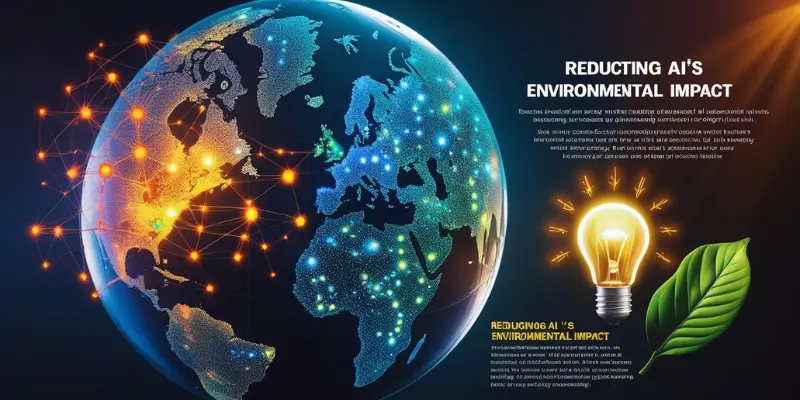
Eco-conscious tech choices are an essential part of reducing your digital footprint. By extending the lifespan of your devices, making informed purchasing decisions, and understanding the energy consumption of emerging technologies like AI, you can play an active role in minimizing the environmental impact of your digital life. Sustainable tech choices not only help you reduce e-waste and energy consumption but also promote a future where technology and the environment coexist more harmoniously.
Sustaining Momentum – Tools & Strategies for Long-Term Balance
Maintaining a sustainable digital balance is not a one-time fix—it’s a lifelong commitment. While a detox or initial changes may set you on the right path, keeping up with these new habits over time requires intentional effort and regular check-ins. In this section, we’ll explore strategies for ensuring that your digital well-being becomes a lasting part of your lifestyle.
Building Accountability Systems for Digital Well-being
To sustain digital balance, it’s crucial to have accountability mechanisms in place. Habits don’t stick unless there is some form of measurement or support. Here’s how to stay consistent:
- Habit Tracking Apps: Using a habit-tracking app can provide you with tangible reminders to stay on track. Apps like Habitica, Streaks, and Way of Life help you set goals, track progress, and celebrate achievements. Whether it’s limiting screen time, setting device-free hours, or maintaining digital boundaries, these tools give you the structure and motivation to stay consistent.
- Accountability Partners or Small Groups: Share your goals with someone who can hold you accountable. Whether it’s a friend, family member, or even an online group, having someone to check in with makes it harder to slip back into old habits. Accountability partners not only remind you of your goals but also celebrate your successes with you.
- Scheduled “Digital Check-ins”: Set up regular reviews of your digital habits. These could be monthly or quarterly “digital check-ins” where you reflect on what’s working, what’s not, and where you need to make adjustments. This helps you course-correct before bad habits have a chance to take hold again. It’s not about perfection—it’s about progress.
Example:
Meet Emma, a writer who struggled with spending too much time on social media. By partnering with her friend, Sarah, they set weekly check-ins to discuss their goals and progress. Having Sarah to share her struggles and successes with helped Emma stay focused and motivated to stick to her boundaries.
Regular Digital Tune-Ups: Re-evaluating & Adapting Your Plan
Life changes, and so do your digital needs. What worked for you a few months ago might not work today, and that’s okay. The key is to remain flexible and be ready to adapt your strategy as needed. Here’s how:
- Recognizing Signs of “Digital Creep”: Over time, it’s easy for old habits to sneak back in. You might find yourself spending more time on social media or checking your phone first thing in the morning. This is what’s called “digital creep.” It’s important to recognize these signs early and adjust your habits before they become ingrained again.
- The “Mini-Detox” or “Digital Sabbath”: A digital detox doesn’t have to be a long-term commitment. Consider implementing shorter, more frequent breaks, like a weekly “digital Sabbath” or a weekend “mini-detox.” These regular resets will help you stay grounded and prevent burnout from digital overload. Use these breaks to reconnect with offline activities like hobbies, nature walks, or spending quality time with loved ones.
- Adapting Your Plan as Technology Evolves: Technology changes rapidly, and so should your approach to it. As new apps, devices, or platforms emerge, assess whether they align with your goals. If you find yourself spending excessive time on a new app or device, re-evaluate its place in your digital routine. Don’t be afraid to update your digital plan regularly to accommodate these changes and ensure it continues to work for you.
Connecting Digital Habits to Your Real-World Well-being & Impact
The real reason behind maintaining mindful digital habits is the positive effect it has on your overall well-being—both mentally and physically. By keeping technology in check, you’re not only improving your health but also contributing to the well-being of the planet. Here’s the deeper connection:
- Improved Sleep: Constant exposure to screens—especially before bedtime—can interfere with your sleep quality. By maintaining a digital balance, you’re likely to experience improved sleep patterns, which in turn, enhances your mood, productivity, and overall health.
- Reduced Anxiety: Mindfully managing your digital habits can help reduce the anxiety that comes from constant information overload and the pressure to stay connected at all times. Setting boundaries and being intentional about when and how you engage with technology creates space for more peace and less stress.
- Increased Presence: The more you consciously choose when and how to use technology, the more present you become in your real-world interactions. Whether it’s at family dinners, during a hike, or while engaging in a creative hobby, being present in the moment will strengthen your relationships and enrich your experiences.
- More Time for Hobbies, Relationships, Nature: The time you save by reducing unnecessary screen time can be reinvested into activities that nourish your soul—whether it’s pursuing hobbies, spending time with loved ones, or enjoying nature. These offline activities promote mental well-being and contribute to a balanced lifestyle.
- The Collective Impact of Individual Sustainable Tech Choices: While individual actions may seem small, when multiplied across millions of people, they add up to significant change. By reducing your digital footprint, you are part of a larger movement towards sustainable living. Every mindful tech decision—whether it’s reducing e-waste, minimizing energy consumption, or supporting ethical tech companies—contributes to the global effort to protect our planet for future generations.
Sustaining your digital balance is about committing to regular check-ins, being flexible in your approach, and aligning your habits with your long-term well-being. By building accountability, adapting your plan as needed, and recognizing the deep connection between your digital habits and real-world benefits, you’ll create a lifestyle that is not only sustainable for you but also for the planet. This is about creating lasting change that empowers you to live a more present, intentional, and eco-conscious life.
Expert Insights & Common Pitfalls to Avoid
The road to sustainable digital habits is not without its challenges. As with any new lifestyle change, there are common mistakes and misconceptions that can hinder your progress. In this section, we’ll highlight some of the top pitfalls to watch out for and offer expert advice to help you stay on track for long-term success.
Top Mistakes to Avoid on Your Sustainable Digital Journey
The path to lasting digital well-being is full of potential stumbling blocks. Here are some of the most common mistakes people make, and how to avoid them:
- All-or-Nothing Thinking:
One of the most damaging mental traps is expecting perfection. Many people start their digital detox with the mindset that they must eliminate all digital distractions at once. However, this often leads to burnout or frustration. The truth is, digital balance isn’t about perfection—it’s about making consistent, small adjustments. Allow yourself room to slip up and learn from it, rather than feeling defeated when things don’t go as planned. - Ignoring the “Why”:
A digital detox or lifestyle change only works when you have a clear understanding of why you’re doing it. If you lose sight of the personal and planetary benefits—improved mental health, better relationships, and reduced environmental impact—you may struggle to stay committed. Revisit your reasons for embracing a mindful tech life regularly to keep your motivation strong. - Isolating the Detox:
Another mistake is treating your detox as a one-off event instead of integrating it into a sustainable lifestyle. A digital detox shouldn’t be an isolated event where you completely cut off from tech for a short period. Instead, it should be part of a larger commitment to mindful digital use. Incorporate the lessons learned from your detox into your everyday habits for long-term success. - Unrealistic Expectations:
Digital detox and sustainable tech habits take time. Expecting immediate results or assuming the process will be easy can set you up for disappointment. Remember, it’s a gradual transition. Your old habits won’t vanish overnight, and you’ll likely encounter challenges. Stay patient with yourself, and celebrate the small wins along the way. - Neglecting Digital Spring Cleaning:
Even after your detox, it’s easy to let digital clutter creep back in. Neglecting regular “digital spring cleaning”—such as unsubscribing from unnecessary emails, deleting unused apps, and organizing your digital files—can quickly lead to overwhelm. Make a habit of periodically reviewing your digital space to prevent unnecessary buildup and maintain a streamlined, intentional digital environment.
Expert Habits for Digital Sustainability Gurus
As you continue on your sustainable digital journey, here are some expert habits to help you stay grounded, maintain momentum, and ensure that digital well-being becomes a permanent part of your lifestyle:
- Implement a “Daily Digital Shutdown Ritual”:
Create a ritual at the end of each day to disconnect from your devices. For example, turn off your devices an hour before bed to promote better sleep hygiene. Use this time for offline activities like reading, meditation, or spending time with family. A digital shutdown ritual helps to establish clear boundaries and signals to your brain that it’s time to relax. - Regularly Review Your “Digital Subscriptions”:
Whether it’s newsletters, apps, or streaming services, it’s easy for digital subscriptions to pile up and overwhelm your inbox or budget. Make it a habit to regularly review and unsubscribe from services you no longer need or use. This practice will help you stay organized and reduce unnecessary distractions. - Practice “Conscious Charging”:
Charging your devices in a conscious way can help reduce energy waste and extend battery life. Unplug your charger when your device is fully charged to avoid overcharging, which can damage the battery over time. Additionally, avoid leaving devices plugged in overnight when not in use. These simple practices contribute to both your personal sustainability and reduce unnecessary energy consumption. - Utilize “Digital Minimalism” Principles Even Outside a Full Detox:
While a full, immersive break like the one explored in our “Ultimate Guide to a Digital Detox: Your 7-Day Journey to Mental Clarity & Balanced Living” can be a powerful reset ,digital minimalism doesn’t just apply to detox periods—it can be a way of life. By regularly reassessing your digital needs and simplifying your devices and habits, you create a more intentional and fulfilling digital existence. Limit the number of apps you use, unsubscribe from unnecessary services, and stay focused on tools and tech that truly add value to your life. - Educate Others Gently About Digital Sustainability:
Once you’ve made positive changes in your own life, share your knowledge with others—gently. Encouraging friends, family, or colleagues to adopt sustainable digital habits can amplify your impact. However, avoid coming across as preachy. Instead, share your experiences and let others make their own choices based on their needs and interests.
Achieving sustainable digital habits requires a mindset shift and an ongoing commitment to small, intentional changes. By avoiding common pitfalls, staying flexible, and adopting expert habits, you can build lasting digital well-being that supports both your mental health and the planet. Remember, this is a journey—not a destination—and each step you take brings you closer to a balanced, intentional relationship with technology.
Conclusion: Your Journey to a Mindful & Sustainable Digital Future
As we wrap up this guide, you’re now equipped with the tools and strategies to go beyond temporary detoxes and build robust, sustainable digital habits. This journey isn’t about perfection—it’s about creating a healthy, intentional relationship with technology that lasts a lifetime. By focusing on mindful tech use, reducing your digital footprint, and fostering greater balance, you are taking significant steps towards a more present, fulfilling life.
Key Takeaways:
- Intentional Tech Use: You’ve learned the importance of engaging with technology mindfully, using it with purpose rather than mindlessly scrolling through endless feeds.
- Reducing Your Digital Footprint: By embracing eco-conscious choices—whether it’s decluttering your digital space, extending the lifespan of your devices, or opting for green tech—you are contributing to a healthier planet.
- Achieving Balance & Presence: The goal isn’t just less screen time—it’s about creating more time for what truly matters. A life of balance, improved well-being, and stronger connections is within your reach through intentional digital habits.
By embracing these strategies, you’ll not only reclaim your focus and reduce anxiety, but also contribute positively to the environment—all through smarter, more conscious tech choices. This journey is one of holistic well-being, where technology enhances rather than detracts from your life.
Ready to make lasting change? Start implementing this action plan today and transform your relationship with technology for good. It’s time to create a sustainable digital future that aligns with your values and supports your well-being.
What’s the first step you’ll take on your journey? Share it in the comments below and let’s support each other in making meaningful, sustainable tech choices!
Beyond the Basics: Expert Answers to Your Sustainable Digital Habits Questions
A digital detox involves taking a break from technology to reset your mind and reduce digital overwhelm. It’s crucial because it helps prevent burnout, reduce stress, and restore a healthy balance between online and offline life.
While there’s no set rule, a digital detox can last anywhere from 24 hours to several weeks, depending on your goals. Even short breaks can help reduce stress and improve focus.
To avoid relapse, focus on setting clear digital boundaries, adopting mindful tech use, and using accountability systems. Regular check-ins and digital spring cleaning are essential for sustaining progress.
Yes! It’s not about eliminating tech, but using it more intentionally. By setting boundaries, creating tech-free zones, and using devices for specific purposes, you can enjoy the benefits of technology without sacrificing your well-being.
Mindful tech use reduces e-waste, lowers energy consumption, and helps minimize carbon footprints. Practices like extending device lifespan, recycling, and opting for eco-friendly products all contribute to a healthier planet.
Start with a digital audit: unsubscribe from unnecessary emails, delete unused apps, and declutter your cloud storage. This reduces digital clutter, helping you feel more organized and focused.
Be intentional about your engagement: limit your time on social media, unsubscribe from irrelevant accounts, and curate your feeds to follow only accounts that align with your interests and values.
Use tools like screen time trackers on your phone to set limits, schedule breaks, and avoid unnecessary distractions. Designating “tech-free” times or zones, such as during meals or before bed, can help maintain balance
Opt for energy-efficient devices, extend the lifespan of your tech through repairs, and choose green hosting providers. Regularly clean up your digital storage and recycle old tech to reduce e-waste.
Absolutely! Digital balance is about using tech wisely, not over-relying on it. Focus on offline activities like reading, exercising, or spending time with loved ones to boost productivity and reduce tech burnout.

- Be Respectful
- Stay Relevant
- Stay Positive
- True Feedback
- Encourage Discussion
- Avoid Spamming
- No Fake News
- Don't Copy-Paste
- No Personal Attacks



- Be Respectful
- Stay Relevant
- Stay Positive
- True Feedback
- Encourage Discussion
- Avoid Spamming
- No Fake News
- Don't Copy-Paste
- No Personal Attacks



